This review covers military events that took place on the territory of Belarus in June 2023. The information is provided as of July 1, 2023.
Summary.
In June, the general activity of the Belarusian Armed Forces didn’t change significantly. The main efforts were still focused on maintaining the readiness of individual elements of national security. No major military drills were recorded.
The Russian component of the joint regional group of troops of Belarus and Russia continues to train in Belarus. About 4800 servicemen of the Russian Armed Forces may be stationed at training grounds and airfields of the Belarusian Armed Forces. In general, we can see changes in the trend from reduction of the Russian contingent in Belarus to its insignificant increase. The activity of the Russian military in Belarus has become routine and cyclic: they arrive in Belarus, train at the training grounds, leave for the combat zone, and other groups of recruits arrive instead. And then the described cycle repeats.
The general medium-term forecast for the military situation in Belarus remains unchanged: there are no reasons to expect an offensive operation by the Russian Armed Forces from the territory of Belarus. Russia still uses the deployment of the regional group of troops to train its military. The Belarusian Armed Forces are still unable to conduct an offensive operation against Ukraine on their own (without the support of the Russian Armed Forces).
Currently, the key destabilizing factors that could change the current military situation in Belarus are the deployment of tactical nuclear weapons and the activities of the PMC Wagner.
Chapter 1. The Armed Forces of the Republic of Belarus (hereinafter – the Belarusian Armed Forces)
1.1 Combat training.
Key points on paragraph 1.1:
- There were no major drills of the Belarusian Armed Forces in June. During the month, combat readiness training was held in the units. Such training is conducted twice a year after the conscription of citizens for active military service, it’s a regular event.
- There were almost no reports on combat coordination activities or joint drills of the Belarusian and Russian units included in the regional group of troops.
- Reservists are constantly involved in combat training. In total, at least 1428 people were drafted for various training sessions in June. The total number of reservists who attended military training sessions during the six months of 2023 is at least 8302 people.
- The major events of combat training of security forces of the Lukashenko regime included interagency anti-terrorist drills held in Homiel region.
1.1.1 The main activities of combat training of the Belarusian Armed Forces.
The Belarusian Armed Forces didn’t conduct any major combat training activities in June. The main efforts were focused on introducing new recruits drafted in spring 2023 for active military service. For this purpose, combat readiness training was conducted in military units, as well as training of army drivers.
It was reported that as part of the week of combat and mobilization readiness, tactical and combat readiness training with the putting military units to the highest levels of combat readiness were conducted. They practiced the actions of units on getting up on alert, deploying personnel reception points, etc. Such events were held in the 1st Anti-Aircraft Missile Regiment, the 8th Radio-Technical Brigade, the 11th Mechanized Brigade, the 16th Separate Regiment of Electronic Warfare, the 38th Air Assault Brigade, the 115th Anti-Aircraft Missile Regiment, the 83rd Engineering Airfield Regiment, the Minsk Military Commandant’s Office, etc. As part of combat and mobilization readiness training, issues of covering units from air attacks were also practiced.
Combat readiness training is scheduled and takes place twice a year after the regular conscription, and after the new recruits have completed the initial military training program.
Based on data from the government procurement portal, we can conclude that the Northwestern Operational Command has begun preparations for the combat readiness inspections announced earlier by Belarus’ Minister of Defense Viktor Khrenin. This is indicated by the public procurement conducted in May of this year. Based on the available data, we can conclude that the 19th and 120th Mechanized Brigades are being prepared for the inspection.
We should also note other combat training activities:
1) Special weapons drills, which began on May 29, continued. The 1562nd technical missile base and the 43rd missile and ammunition arsenal took part in the drills. During the drills, they practiced the issues of management of technical support forces, providing units with missiles (for the Tochka-U missile system and the Osa SAM system), countering sabotage and reconnaissance groups and unmanned aerial vehicles (hereinafter — UAVs).
2) Instructional and methodological training on the organization and conduct of combat coordination was held with officers of the 51st Artillery Brigade. During the training, ways of restoring skills in weapons use and training of servicemen were discussed.
3) From June 13 to June 16, 2023, under the leadership of the Chief of Logistics of the Belarusian Armed Forces, command-staff drills with the bodies of military logistics management were held.
4) Tactical drills with the personnel of the 115th Anti-Aircraft Missile Regiment were held at the Brestski training ground. During the drills, they practiced changing positions, organizing guards, and countering sabotage and reconnaissance groups and UAVs.
5) The 2284th Separate Radio Technical Battalion of the 8th Radio Technical Brigade conducted activities to protect and defend a permanent deployment point. Tactical drills were also held in one of the battalion’s units. During the drills, the unit relocated to a designated area to perform combat training tasks.
6) From June 26 to June 30, 2023 special tactical drills “Help-2023” were held at the 1134th Military Clinical Medical Center of the Belarusian Armed Forces. The purpose of the drills was to practice therapeutic and evacuation measures during a mechanized brigade’s defensive operations. Russian military doctors also performed at the drills.
The dates of the drills of the Collective Security Treaty Organization (hereinafter — CSTO) on the territory of Belarus became known. From September 1 to September 6, the following drills will be held: “Interaction-2023” joint drills with the rapid reaction forces of the CSTO, “Search-2023” drills with the intelligence forces, “Echelon-2023” drills with the logistical support forces, “Barrier-2023” drills with the joint forces of radiation, chemical and biological defense and medical support, “Rock-2023” drills with units of the Ministry of Emergency.
Despite numerous statements about an active adoption of the experience of combat operations and strengthening the protection of the border with Ukraine, the Belarusian Armed Forces remain formalist in their training. This situation is well illustrated by the footage of soldiers of the Special Operations Forces strengthening the protection of the border with Ukraine.
It should also be noted that in June there were almost no reports about joint combat training activities of the Belarusian and Russian units included in the regional group of troops. The exception was the training of the aviation component of the regional group of troops during the Airforce drills with the 116th assault aviation base of the Belarusian Armed Forces (see paragraph 1.2.3 of Chapter 1). The absence of joint drills and other combat training is an additional confirmation that the deployment of the regional group of troops was necessary just to organize the training of the Russian military on the territory of Belarus.
1.1.2 Specifics of combat training of other security forces.
Among the significant events of combat training, we can note interagency anti-terrorist drills, which were held from June 5 to June 7 in Homiel region. Units of the Ministry of Internal Affairs, Border Guard Service, State Security Committee, Belarusian Armed Forces, and others took part in the drills. Tasks of suppression of activities of terrorist organizations and illegal armed groups were practiced during the drills. These are not the first anti-terrorist drills held this year. For example, in February, similar drills were held in Buda-Kashaliova (Homiel region) and Klichau (Mahiliou region) districts. Such drills are aimed at counteracting the actions of Belarusian volunteers fighting on the side of Ukraine.
It was also reported that Phoenix separate special purpose detachment was formed at the 4th militia battalion of the internal troops (military unit 5522, Hrodna). It was reported that the detachment was actively engaged in combat training. We recall that the formation of new special units in the structure of the internal troops began in autumn 2022. Their main task is to counter sabotage and reconnaissance groups and illegal armed formations.
It was reported that six reinforced groups of the internal troops and special units of the Ministry of Internal Affairs are currently operating in the border area in all complicated areas (which ones were not specified), carrying out tasks to protect the state border, railroads and strategically important facilities. It also became known that servicemen of Hrodna, Homiel and Brest border guard groups, as well as Pinsk border guard detachment provide protection of the state border with Russia.
1.1.3 Training sessions with reservists.
Active training sessions with reservists continued in June. For example, reservists were involved in arms drills, which were held from May 29 to June 2. According to available information, reservists were drafted to the 1562nd technical missile base and the 43rd missile and ammunition arsenal to take part in the drills.
It also became known that from June 6 to June 30, the 72nd joint training center held a training session with reservists drafted from Homiel region and Minsk. According to available information, a total of 646 people were drafted to the training session. In general, it was a training session for the mechanized brigade cadre units (mechanized and tank battalions, artillery and air defense units, and the brigade’s management).
From June 19 to June 28, the internal troops held a training session with servicemen and reserve personnel who served in special purpose units of the Ministry of Internal Affairs. In total, more than 250 people were drafted to the training session. Tactical, firearms, physical and medical training was conducted under the supervision of instructors. The reservists studied the material equipment of 82-mm mortars, automatic grenade launchers (AGS-17 and AGS-30), as well as weapons in service with special units of the Ministry of Internal Affairs. It was announced that similar training sessions would be held in regional centers of Belarus as well.
There were reports of training sessions with reservists in the 120th Anti-Aircraft Missile Brigade (at least 7 reservists), the 25th missile and artillery arsenal (at least 9 reservists), the 19th Mechanized Brigade and the 86th Signal Brigade. The total number of reservists taking part in these training sessions is unknown.
It was reported that the military commissariats of Svetlahorsk and Aktsiabrski districts, Vileika, Stoubtsy and Pukhavichy districts sent reservists to military training sessions (at least 11 reservists). It was also reported about the return of reservists from military training sessions to military commissariats of Niasvizh and Kopyl districts (at least 9 reservists), Kletsk and Vileika districts.
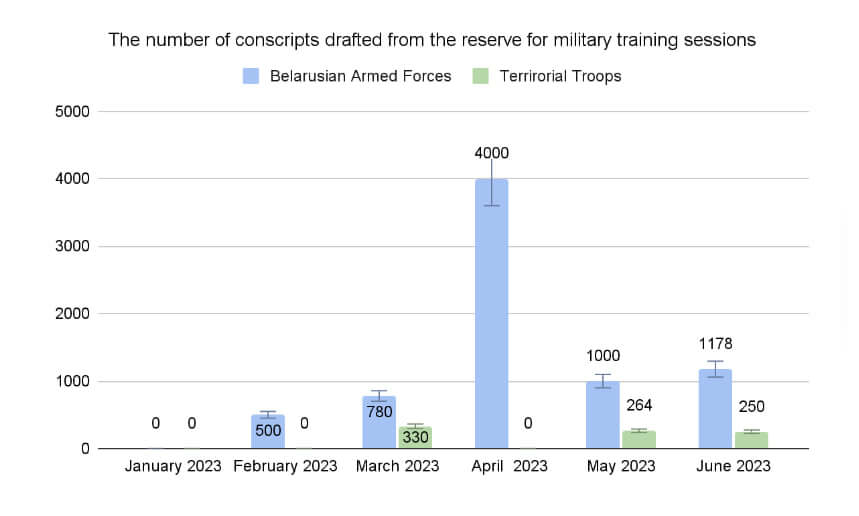
According to clarified information, 264 reservists were drafted to training sessions with the territorial defense in Mazyr district, Homiel, and the Leninski district of Minsk in May. It was also reported that about 250 reservists were drafted to training sessions of the territorial defense in June, and another 255 — to mobilization drills with the military commissariats of Minsk region (see paragraph 1.3.3 of Chapter 1).
Thus, the total number of reservists drafted to training sessions in June can be estimated to be at least 1428 people. In total, at least 8302 people have already been drafted for various types of training sessions from January to June 2023. We note that this is the lowest number of reservists, since we don’t know about all the military training sessions that have been held. Therefore, in reality, the number of reservists who have passed military training sessions can be estimated at 9000 people. Earlier, the Ministry of Defense of Belarus reported its plans to draft 9000 people for training sessions in 2023.
1.2. Movements of military equipment. Aviation activity.
Key points on paragraph 1.2:
- The intensity of movements of columns with equipment of the Belarusian Armed Forces slightly decreased compared to May. There was nothing unusual in the movements of military equipment.
- The intensity of movements of the Belarusian Armed Forces by rail also decreased compared to May. This is primarily connected with the fact that no major combat training activities were reported in June
- No increase in the flight activity of the Belarusian Air Force was recorded.
- The general nature of movements of the Belarusian Armed Forces doesn’t allow us to conclude that troops are being concentrated to commit an act of aggression against Ukraine.

The intensity of movements of both military and combat equipment of the Belarusian Armed Forces slightly decreased compared to May. This is connected with the fact that there were no reports about major drills in the Belarusian Armed Forces in June. In general, movements of equipment of the Belarusian Armed Forces detected during the monitoring were connected with daily activities of military units, as well as training of drivers drafted for active military service.
We can distinguish the following main routes of military equipment’s movements: Minsk-Asipovichy, Minsk-Baranavichy, Zhodzina-Barysau, Minsk-Biahoml, Zhlobin-Homiel, etc. Military equipment was also recorded in the following towns and cities, where large garrisons of the Belarusian Armed Forces are located: Baranavichy, Vitsiebsk, Minsk, Barysau, Mazyr, Hrodna, Mahiliou, etc.
The highest activity of military equipment’s movements was recorded in Brest region (on the М1 highway and near Baranavichy), Minsk region (on the М1, М3, М5, R23, R53 highways, MKAD, near Minsk and Barysau), as well as in Homiel region (on the M5 highway, near Homiel and Mazyr).
In general, there was nothing unusual in the movements of military equipment of the Belarusian Armed Forces. More detailed dynamics of movements of equipment of the Belarusian Armed Forces can be seen on our interactive map.
1.2.2 Movements of troops by rail.
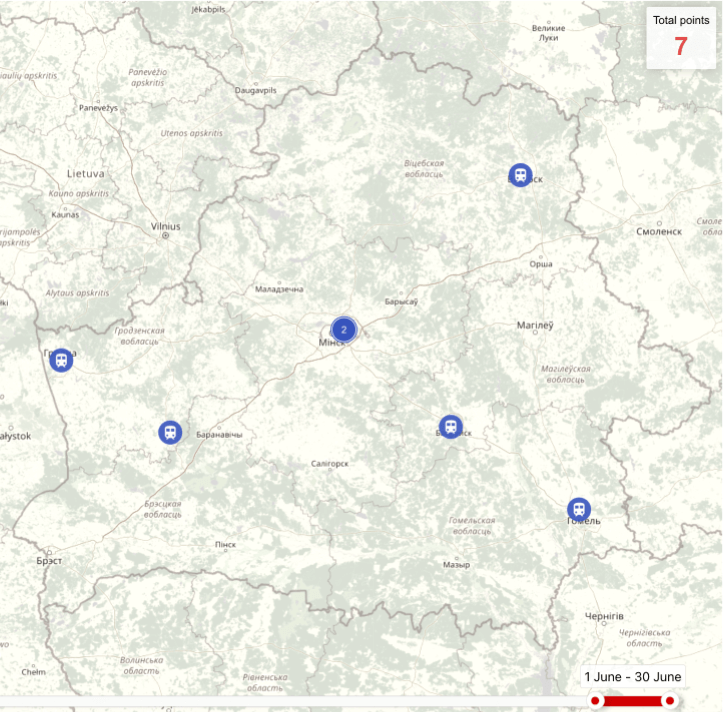
The intensity of movements of the Belarusian Armed Forces by rail decreased twofold compared to May and was generally insignificant. This is connected with the fact that no major combat training activities were reported in June, as well as with the lack of information about the rotation of units providing reinforced protection of the border with Ukraine.
During the month, we recorded movements of units of the 103rd Airborne Brigade, the 147th Anti-Aircraft Missile Regiment, and the 6th Mechanized Brigade by rail.
1.2.3 Aviation activity.
The intensity of flights of the Belarusian Air Force remained at the same level as in May. Lida, Baranavichy, and Machulishchy airfields were mainly used for flights of the Belarusian Air Force. They also used Luniniets, Babruisk, Asautsy, Balbasava airfields, and Homiel airport. The entire helicopter and aircraft fleet of the Belarusian Armed Forces was involved in the flights.
It should be noted that from June 21 to June 23, Airforce drills were conducted with the 116th assault aviation base on the topic “Conducting combat operations by an aviation base.” During the drills, the following issues were practiced:
- interaction with the air gunner’s control center;
- simulation of landing on a section of a road;
- flights under conditions of radio communication and state identification system interference;
- landing at operational and contaminated airfields.
During the drills, the issues of suppressing enemy air defense systems, disabling the command post, and striking concentrations of enemy equipment and manpower were practiced at the Ruzhanski training ground. They also practiced breaking the enemy’s air defense system at extremely low altitudes. It was reported that the practical actions of the aviation component of the regional group of troops of Belarus and Russia were practiced.
It should be noted that the Il-22VPU air command post aircraft arrived from Russia to take part in the drills.
There were no other specifics in the combat training of the Belarusian Air Force during the month.
1.3. Activity of military commissariats.
Key points on paragraph 1.3:
- Activities of military commissariats were conducted in normal mode in June.
- Active draft of persons liable for military service to military training sessions continued.
- Drills with the territorial troops continue to be regularly conducted. Training sessions with reservists of the territorial troops were held in two regions of Belarus in June. In general, there is a tendency to increase the number of such drills.
1.3.1 Military and mobilization work.
In June, military commissariats implemented military mobilization activities. It was reported that trainings were held with employees of organizations responsible for military registration and reservation of persons liable for military service, as well as in the conduct of mobilization work. It was also reported on inspections of mobilization readiness of organizations to provide vehicles, the training on the organization and procedures of the notification and assembly point for persons liable for military service.
From June 6 to June 9, military commissariats of Minsk region held combat readiness trainings. Their main purpose was to prepare for the work of the military commissariat during the transfer from peacetime to wartime. Similar trainings were reported to be held in Homiel region.
Also, from June 21 to June 30, 2023, mobilization drills were held in Minsk region. During the drills, the transfer of military commissariats from peacetime to wartime was practiced. In total, 255 reservists were drafted from the reserve. As part of the drills, the infrastructure for the mobilization of citizens and vehicles was deployed. Similar drills are conducted annually in different regions of Belarus.
Active conscription of persons liable for military service into military training sessions continued in June (see paragraph 1.1.3 of Chapter 1).
1.3.2 Registration and conscription work.
Among the registration and conscription activities in June, we should note the ongoing conscription of reserve officers for military service. The conscription is conducted according to the decree of March 10, 2023. The document envisages the conscription of up to 230 reserve officers into the Belarusian Armed Forces in 2023, and up to 20 more — into the border guard bodies.
There were no reports on verdicts for evading active military service in June.
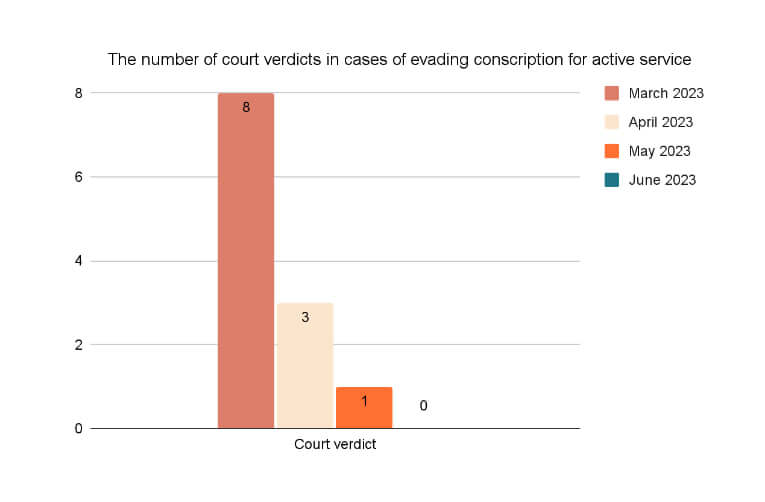
1.3.3 Territorial defense. National home guard.
A number of activities aimed at improving the capacity of the territorial defense troops were reported in June. First, we can mention the ongoing training sessions with the territorial troops.
For example, from June 8 to June 29, a training session with the territorial defense was held in the Luninets district, Brest region. At least 100 persons liable for military service were drafted from the reserve. During the training session, the issues of service at the control checkpoint, security of a life support facility and countering sabotage and reconnaissance groups were practiced. The training session ended with command staff drills. A national home guard unit was formed during the training session. The program of the training session is standard for this type of activity.
It was also reported that from June 27 to July 21, a training session with the territorial defense would be held in the Salihorsk district, Minsk region. At least 150 persons liable for military service will be drafted from the reserve. The training camp will end with the command staff drills with the territorial defense forces of the Salihorsk district. It’s also planned to hold a one-day training session with the chairmen of district executive committees of the region on the organization of territorial defense.
It should be noted that according to the decision of the Ministry of Defense of Belarus, military training sessions with the territorial defense forces will be held annually from 2024 not in one, but at least in two districts of each region.
1.4. Work of the military-industrial complex.
Key points on paragraph 1.4:
- The production of 122-mm rocket shells has been established in Belarus. However, there are no grounds to claim that the production of such ammunition is put on stream.
- Currently, plans to modernize 20-30 tanks for the Belarusian Armed Forces in 2023 are in jeopardy.
- Work on the development of new UAVs of various types continues.
We can note the following in the work of the military-industrial complex of Belarus in June.
It was reported that serial production of 122-mm rocket shells was launched in Belarus. Work on the production was launched in November 2022. More than 20 enterprises within the system of the State Military Industrial Committee and the Ministry of Industry are working on the production of ammunition. The final assembly of ammunition is performed by the state-owned enterprise Precision Electromechanics Plant. However, at the moment we can’t speak about mass production of rocket shells. As the officials themselves note, the final assembly of the items is done manually.
We can also note that the plans announced earlier by Lukashenko’s officials to modernize 20-30 T-72 tanks annually to the level of the T-72BM2 are in jeopardy. So far, we can state that state tests of the new tank are still underway, and serial production of the modernized samples hasn’t started.
Development of new Belarusian UAVs continues. For example, on June 14, a scientific and practical seminar on relevant issues of UAV use was held at the 927th center for training and use of unmanned aerial systems of the Belarusian Armed Forces. Promising UAV models produced by Belarusian enterprises were demonstrated at the event. These included the Yastreb and Kvadro-M experimental UAV prototypes. It was reported that research tests of the Berkut-3 reconnaissance UAV and Mirotvorets attack UAV are currently underway. Work is also underway to develop the Chekan-V and Klevets kamikaze drones.
1.5. Supplies of new samples of military equipment to the troops.
Key points on paragraph 1.5:
- New equipment was supplied to the electronic warfare unit of the Special Operations Forces of the Belarusian Armed Forces.
- Different types of UAVs, produced both in Russia and Belarus, are purchased in small batches for the needs of the Belarusian Armed Forces.
It was reported about new samples of military equipment supplied to the Belarusian Armed Forces in June.
For example, on June 2, electronic warfare systems were handed over to one of the newly formed electronic warfare units of the Special Operations Forces. At least two pieces of equipment were handed over, their type and characteristics are unknown.
The S-400 SAM system, which arrived in Belarus at the end of May, was supplied to the 6th divizion of the 15th Anti-Aircraft Missile Brigade of the Belarusian Armed Forces. The divizion’s firing positions are located in the vicinity of Dubrova village (Smaliavichy district, Minsk region). On June 30, the Ministry of Defense of Belarus reported that the S-400 divizion set had been put on combat duty.
Procurement of new equipment continued. In June, the Belarusian Ministry of Defense began the procedure for purchasing two sets of Supercam S350 UAVs and one set of Supercam S150. In total, from 2020 to 2022, the Belarusian Defense Ministry has bought 7 Supercam S350 and one Supercam S150 UAVs from Russia. As we can see, there is no talk about mass purchase and transfer of new UAVs to the troops. It’s more of a matter of replacing previously purchased UAVs that are no longer operational.
It was reported on plans to sign contracts by the end of 2023 for the supply of the Kvadro-1400 and the Barrazhiruyushchaya truba UAVs to the Belarusian Armed Forces. It’s also planned to supply the Busel-10 UAV to the troops in 2023.
It was also reported that a batch of at least six Volat V1 (MZKT-490100-217) armored vehicles was supplied to the internal troops.
1.6. Military construction. Development of military infrastructure.
Key points on paragraph 1.6:
- The composition of units of the Special Operations Forces of Belarus was complemented with a new electronic warfare unit.
- The construction of a military town for the Special Operations Forces of the Belarusian Armed Forces started in the Homiel district. It’s not yet known which unit will be accommodated in the new military town.
- Work is underway to create the “Khrenin’s line,” a network of fortified areas to protect Belarus in case of an act of external military aggression against the country.
- Over the past year, after the announcement of the formation of the Southern Operational Command, the Ministry of Defense of Belarus hasn’t taken any significant practical steps to create it.
As for the military construction, we can note that an electronic warfare unit was formed within the Special Operations Forces of the Belarusian Armed Forces. At the moment, nothing is known about the new unit. Judging by the amount of equipment that has been handed over to it, we may be talking about the formation of up to a separate electronic warfare company.
We should also note that over a year ago, on May 26, 2022, Lukashenko publicly announced the formation of a new operational command — the Southern —within the Belarusian Armed Forces. In general, we can state that over the past year, the Ministry of Defense of Belarus hasn’t made significant progress in it. Therefore, at the moment, the prospects of its formation are still quite far away from real implementation. As our analysis has shown, the creation of a new operational command will require solving a whole set of problems. Time will show whether the Belarusian Defense Ministry will be able to solve them.
The military infrastructure continued to develop. For example, the construction of a military town for the Special Operations Forces of the Belarusian Armed Forces began in the Homiel district. It should be noted that the state investment program for 2023 included the construction of a training ground and a military town in Homiel region for the forming Southern Operational Command. Based on data from open sources, it became known that the military town would be built on the basis of several abandoned children’s camps in the Homiel district. There were no official comments from Lukashenko’s officials on the start of the construction.
In turn, works on the engineering equipment of firing positions, which include the construction of a system of trenches and dugouts, began in the vicinity of Saki village (Zhabinka district, Brest region). Based on the scale of the construction, we can conclude that we are talking about the construction of a stronghold, which may be part of a fortified area. The available information allows us to conclude that Lukashenko’s officials have plans to build fortified areas in the most dangerous areas of potential military aggression against Belarus. In this case, we are talking about the western and southern regions of Belarus, bordering NATO countries and Ukraine. Currently, there’s information about two fortified areas: in the Homiel and Zhabinka districts. Thus, after being just a joke of journalists, the “Khrenin’s line” has started to become real. Apparently, conceptually, it will be a set of connected strongholds and fortified areas that will cover critical infrastructure objects and the most likely directions of potential military aggression. Both the territorial troops and the Belarusian Armed Forces will be able to keep defense in the fortified areas.
1.7. Amendments to the legislation in the military sphere.
Key points on paragraph 1.7:
- The adopted amendments to the law “On martial law” are aimed primarily at counteracting the Belarusian volunteers who are currently fighting on the side of Ukraine, as well as other paramilitary organizations that keep the possibility of a forced overthrow of the Lukashenko regime.
- Belarus and Russia continue formalizing cooperation in the military sphere. We note that the legal formalization may differ from the status quo by several years.
Speaking of legislative innovations related to national security, we can note the following:
1) A draft law on amendments to the law “On martial law” was introduced to the “parliament”. According to the draft law, the grounds yo impose the martial law will be the actions of another state that allows the use of its territory by a third state, extremist groups and organizations to attack Belarus, as well as the sending of armed gangs, irregular forces, mercenaries or units of regular troops to the territory of Belarus.
2) The “parliament” adopted the draft law “On ratification of the Agreement between Belarus and Russia on the establishment and operation of training and combat centers for joint training of servicemen of the Belarusian and Russian Armed Forces”. The document regulates the organization, establishment and functioning of combat training centers, defines their main tasks and procedures for cooperation between the Defense Ministries in the organization of supply of these centers. We note that training and combat centers actually began to be created back in summer 2021. However, their legal status has been formalized only now.
3) A law on ratification of the Agreement between Belarus and Russia on joint provision of regional security in the military sphere of December 19, 1997 signed in Minsk on December 3, 2022, was signed. It was reported that the protocol was signed to improve the legal framework for bilateral military cooperation. The protocol clarifies the conceptual framework and the procedure for planning and financing joint activities to ensure the operation of the regional group of troops. The specific content of the document is not known yet.
1.8.Transfer of weapons, ammunition, and military gear by the Lukashenko regime to Russia.
Key points on paragraph 1.8:
- No facts of the transfer of military equipment and ammunition by the Lukashenko regime to Russia were recorded in June.
No new reliable facts of the transfer of military equipment, ammunition, and gear to Russia by the Lukashenko regime were recorded in June. This indicates that the equipment and ammunition at the disposal of the Belarusian Armed Forces are limited, and during the full-scale invasion, these resources could have been partially spent.
According to clarified information, from January 2022 to January 2023, the Lukashenko regime transferred 131,582 tons of ammunition to Russia. The ammunition was transferred from:
- the 43rd missile and ammunition arsenal;
- the 46th missile and ammunition arsenal;
- the 391st artillery base;
- the 1393rd artillery ammunition base;
- the 1405th artillery base;
- the 1868th artillery weapons base;
- the 4970th engineering ammunition base.
1.9. Tactical nuclear weapons in Belarus.
Key points on paragraph 1.9:
- At the moment, there is no confirmed information about the transfer of Russian TNW to Belarus.
- According to available information, TNW is to be supplied to the 2631st aviation base of missile weapons and ammunition of the Belarusian Armed Forces, from where it will be distributed to the final storage sites.
- The nature of the contradictory statements about the deployment of TNW in Belarus may indicate a coordinated disinformation campaign.
A number of statements about the deployment of tactical nuclear weapons (hereinafter — TNW) in Belarus were made in June. As before, the statements sometimes contradicted each other.
On June 9, Vladimir Putin said that the deployment of TNW in Belarus would begin after July 7-8, when preparation of sites for their deployment was completed. On June 16, speaking at the St. Petersburg International Economic Forum, Putin said that Russia had transferred part of its nuclear weapons to Belarus. However, this statement was later actually denied by Russian Foreign Minister Sergey Lavrov.
Aleksandr Lukashenko also made a number of statements about TNW. For example, on June 13, in an interview with Russian propagandist Olga Skabeyeva, Lukashenko said that the deployment of Russian TNW had begun on the territory of Belarus. Lukashenko confirmed the same thesis on June 27. According to him, TNW won’t be guarded by mercenaries from the PMC Wagner: the TNW is guarded by the Belarusian and Russian military.
According to information from the Community of Railway Workers of Belarus, TNW will arrive in Belarus by rail in several stages. In the first (June 2023) and the second (November 2023) stages, a total of 16 special cars designed for the transportation of TNW are to arrive in Belarus. Additionally, in October-November 2023, equipment necessary for the storage and maintenance of TNW is to be delivered to Belarus.
Trains with TNW will go to Prudok station (Haradok district, Vitsiebsk region) and then to the 2631st aviation base of missile weapons and ammunition (military unit 94017), which will serve as a training base for unloading and loading, security, and routine maintenance. Subsequently, TNW will be distributed to final storage sites on the territory of Belarus
At the moment, there is no confirming information about the beginning of the real transfer of TNW to Belarus.
The nature of Putin’s (and other Russian officials’) contradictory statements, as well as Lukashenko’s statements about the deployment of TNW in Belarus, may indicate a coordinated disinformation campaign. The goals of such a campaign could be, for example, pressure ahead of the NATO summit that will be held in Vilnius on July 11-12.
For more information about possible locations for TNW deployment, see the brief dated April 4, 2023, “Where a tactical nuclear weapons storage may be built in Belarus?”
Chapter 2. The Armed Forces of the Russian Federation (hereinafter – the Russian Armed Forces)
2.1. Deployment of the regional group of troops.
Key points on paragraph 2.1:
- About 4800 servicemen of the Russian Armed Forces included in the regional group of troops may be stationed at training grounds and airfields in Belarus. In total, there may be about 6850 Russian servicemen in Belarus.
- The delivery of equipment and personnel of the Russian Armed Forces from Russia was recorded. According to our estimates, at least 43 pieces of military equipment and about 380 personnel could have been brought to Belarus.
- No withdrawal of equipment and personnel of the Russian Armed Forces from Belarus was recorded.
2.1.1 Rotation of personnel and equipment of the Russian Armed Forces in Belarus.
The intensity of the redeployment of Russian troops to the territory of Belarus in June decreased compared to April and May. We only observed the redeployment of personnel and military equipment of the Russian Armed Forces from Russia to Belarus. These movements were mostly conducted by rail.
We recorded the following military cargo trains with equipment and personnel of the Russian Armed Forces:
1) On June 2, a military cargo train consisting of 7 passenger cars arrived at Liasnaya station (Baranavichy district) from Smolensk (Russia).
2) On June 3, a military cargo train of the Russian Armed Forces was being unloaded at Asipovichy-1 station. It was reported about at least 22 artillery weapons and one truck.
3) On June 6, a military cargo train of the Russian Armed Forces was being unloaded at Asipovichy-1 station. It was reported about at least 6 Grad MLRS and one freight car.
4) On June 17, a military cargo train with equipment of the Russian Armed Forces (10 T-80BVM tanks and 3 BMP-3 infantry fighting vehicles) was spotted at Orsha-Centralnaya station and in Baranavichy. It should be noted that the tanks looked new.
In total, at least 4 military cargo trains with equipment and personnel of the Russian Armed Forces arrived in Belarus in June: at least 43 pieces of wheeled and tracked vehicles, ≈378 personnel.
Thus, we can state that from May 12 to June 6, there was another wave of rotation of the contingent of the Russian Armed Forces stationed in Belarus. The main phase of the rotation took place between May 12 and May 25. As before, the rotation was as follows: trained Russian units were sent from Belarus to the combat zone, while new Russian servicemen (mobilized, volunteers) arrived from Russia for training at the training grounds of the Belarusian Armed Forces.
During the rotation, at least 3 military cargo trains with equipment and personnel of the Russian Armed Forces (109 wheeled and tracked vehicles, ≈540 people) left Belarus. In turn, at least 8 military cargo trains with equipment and personnel of the Russian Armed Forces (207 wheeled and tracked vehicles, ≈1240 people) arrived in Belarus.

We recall that previously we have already recorded two rotations of the Russian contingent stationed in Belarus. These rotations took place in January (the main phase was from January 5 to January 14) and February-March (the main phase was from February 24 to March 4). Previously, the Lukashenko regime had publicly confirmed that the Russian military were in Belarus on a rotational basis.
We note that military cargo trains of the Russian Armed Forces arrived at Liasnaya station (Obuz-Liasnouski training ground) and Asipovichy-1 station (Asipovichski training ground). Thus, we may assume that the most intensive training of the Russian military is currently taking place at the training grounds mentioned above.
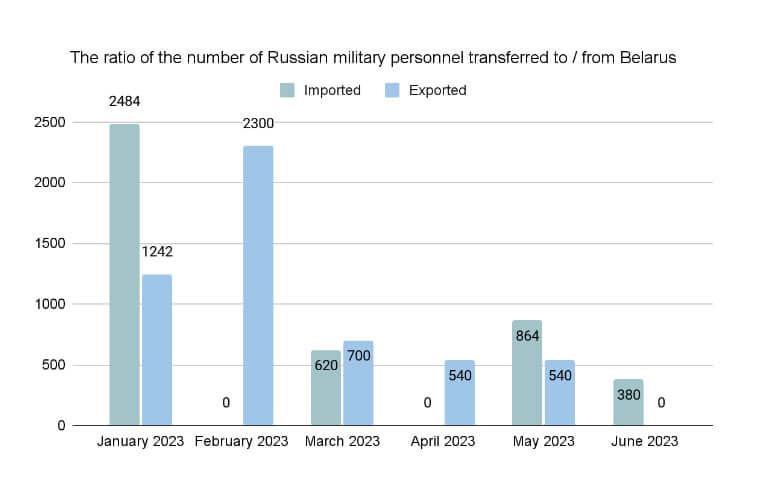
Based on all the mentioned above, we can conclude that there was a slight increase in the number of Russian troops included in the regional group of troops stationed in Belarus. This is primarily connected with the buildup of the number of trained reserves, and not with the preparation of a new offensive operation from the territory of Belarus.
We should add that the formation of a military investigative department of the Investigative Committee of Russia in Belarus completed the creation of key Russian military law enforcement agencies. We may assume that the need to locate such structures in Belarus may be connected both with crimes committed by the Russian military and plans for a permanent Russian military presence on the territory of Belarus.
2.1.2 Estimates of the Russian contingent included in the regional group of troops.
As of early June, we estimated the number of Russian military personnel that could have currently been stationed on the territory of Belarus at about 4500 people.
We note that in June we didn’t receive relevant satellite images of the location of the Russian military at the training grounds of the Belarusian Armed Forces. The relevant data that we have at our disposal are presented below:
— The 230th combined arms training ground Obuz-Liasnouski: about 226 tents (5 USB-56, 22 M-10, 199 M-30), 100 pieces of military equipment (as of May 9).
— Lasvida training ground of the 103rd Airborne Brigade: about 78 residential tents and 10 pieces of military equipment (as of March 20).
— Asipovichski training ground of the 51st Artillery Brigade (Repishcha): about 44 tents (1 USB-56, 5 M-10, 38 M-30), 42 pieces of military equipment (as of May 9).
— Liepielski training ground of 19th Mechanized Brigade: about 95 tents, 73 pieces of military equipment (as of March 19).
— Brestski training ground of the 38th Air Assault Brigade: about 53 tents, 77 pieces of military equipment (as of March 19).
Note of July 5. According to recent data from satellite images, some field camps of the Russian Armed Forces are being liquidated at the training grounds of the Belarusian Armed Forces. For example, as of July 4, field camps at the Obuz-Liasnouski training ground (works began no later than June 30), Liepielski training ground, and Asipovichski training ground (works began no later than July 2) were almost completely dismantled. Field camps have existed at these training grounds since October 2022. In this regard, the estimates of the number of the Russian military stationed in Belarus as of July 1 given below may no longer be relevant.
It’s important to note that there is no talk about the complete withdrawal of the Russian military from the territory of Belarus. For example, since July 2, rail activity and rotation of part of the Russian contingent stationed in Belarus has been recorded.
Based on the information given above, it’s currently impossible to reconsider the size of the Russian contingent in Belarus (given the liquidation of field camps and the ongoing rotation) without additional information about the processes described above.
Also, a small aviation group is concentrated at Machulishchy, Lida and Baranavichy airfields (at least 60 flight personnel, the total flight and technical staff may amount to 100-200 people).
The assessment of the size of the Russian contingent stationed in Belarus is complicated by the fact that the number of residential tents at the training grounds can’t match the number of military personnel stationed at the training grounds, since tent camps have been unchanged for a long time.
Based on the available data (primarily on the movements of the Russian contingent in June, see paragraph 2.1.1 of Chapter 2), we can estimate the number of servicemen of the Russian Armed Forces stationed in Belarus at around 4800 people. It’s important to note that there are currently fewer Russian military personnel in Belarus than there were in autumn 2022-winter 2023. We recall that earlier the Ministry of Defense of Belarus stated that the size of the Russian contingent of the regional group of troops would not exceed 9000 people.
It’s important to note that the number of the Russian military in Belarus is not static and is constantly changing. There are also not only Russian military personnel on the territory of Belarus, who are formally part of the regional group of troops.
For example, Russian servicemen are stationed at two military facilities that have been operating since the mid-1990s. These are the Baranavichy radar station and the Russian Navy’s 43rd communication center in Vileika (the total number of service personnel under the terms of intergovernmental agreements is up to 1450 people). Also, there are Russian military personnel on the territory of Belarus permanently stationed at the airfield in Vialiki Bokau village and Ziabrauka airfield (in total, about 600 people; see paragraph 2.4 of Chapter 2) without any legal status. Formally, the military facilities listed above are not part of the so-called regional group of troops.
Thus, the total number of Russian military personnel stationed in Belarus can be estimated at 6850 people. Of these, from the regional group of troops — 4800; stationed at operating and abandoned airfields without legal status — about 600 people; stationed at the Baranavichy radar station and the 43rd communication center — up to 1450 people.
We note that the Russian military are mainly stationed at the training grounds of the Belarusian Armed Forces in northern and central Belarus, at a distance from the border with Ukraine.
2.1.3 Combat training of the regional group of troops.
Russian and Belarusian propaganda didn’t report on combat training of the Russian military at the training grounds in Belarus during the month. There were also almost no reports about joint combat training of units of the Russian and Belarusian Armed Forces (see paragraph 1.1.1 of Chapter 1).
The available information on combat training of the Russian military can be found in the review of the main military events in Belarus for April 2023.
2.1.4 Daily activities of the Russian military.
In general, the situation with the daily activities of the Russian military didn’t change significantly in June. The locations where Russian servicemen were spotted didn’t change significantly compared to previous months.
Servicemen of the Russian Armed Forces are often spotted in settlements located near the training grounds of the Belarusian Armed Forces. During the month, Russian servicemen were spotted in Baranavichy, Mazyr, Homiel, and Liepiel.
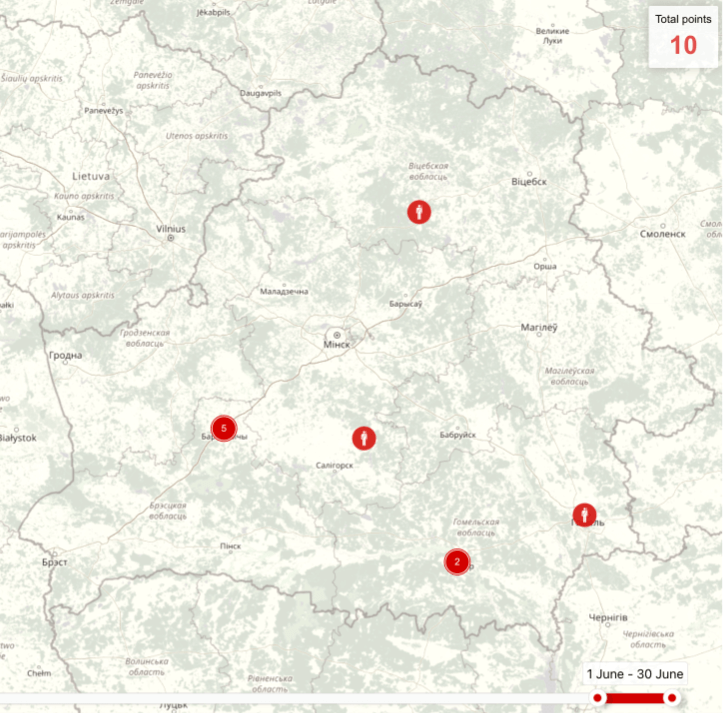
Most often, the Russian military visit shopping centers, grocery stores, household stores and pharmacies on weekends.
2.2 Movements of military equipment. Aviation activity.
Key points on paragraph 2.2:
- The intensity of movements of equipment of the Russian Armed Forces remained at the same level as in May.
- There were almost no movements of equipment of the Russian Armed Forces recorded in the areas bordering Ukraine.
- The level of movements of the Russian Armed Forces by rail decreased compared to May.
- There was an increase in the number of arrivals of military transport aircraft of the Russian Aerospace Forces in Belarus.
2.2.1 Movements of military and combat equipment by road.
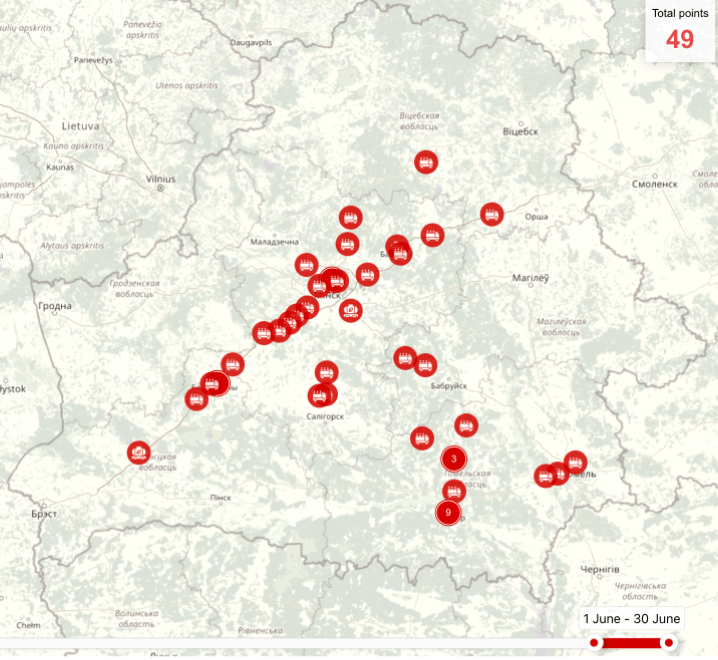
The intensity of movements of both military and combat equipment of the Russian Armed Forces remained at the same level as in May. There were almost no columns with combat equipment.
The highest activity of movements of military equipment were recorded in Brest region (on the M1 highway), Homiel region (on the M5 highway, near Homiel and Mazyr), in Minsk region (on the M1, M3, R23 highways and near Minsk), as well as in Vitsiebsk region (on the M1, M3 highways). Almost no equipment of the Russian Armed Forces was recorded in the areas of Belarus bordering Ukraine. The main routes of movements of equipment: Minsk-Baranavichy, Asipovichy-Minsk, Minsk-Orsha, Minsk-Liepiel, etc. Military vehicles were also spotted in the following towns and cities: Minsk, Mazyr, Slutsk, Homiel, etc.
Most of the vehicles of the Russian Armed Forces had license plates with region 50 (Western Military District of the Russian Armed Forces). We note that vehicles of the Russian Armed Forces were also often moving without license plates.
More detailed dynamics of movements of equipment of the Russian Armed Forces is available on our interactive map.
2.2.2 Movements of troops by rail.
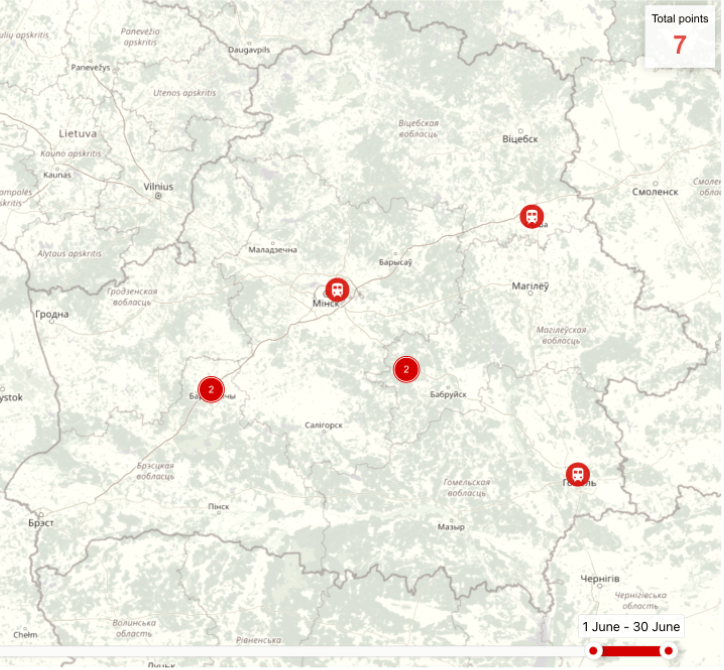
The intensity of movements of the Russian Armed Forces by rail decreased almost twofold compared to May. During the month, we detected the arrival of at least four military cargo trains with equipment and personnel of the Russian Armed Forces to Belarus (see paragraph 2.1.1 of Chapter 2). In general, we can note that movements of the Russian Armed Forces by rail continue to be episodic, rather than constant.
The nature of the railroad movements allows us to state that there is no accumulation of forces and means for conducting offensive operations from the territory of Belarus.
2.2.3 Aviation activity.
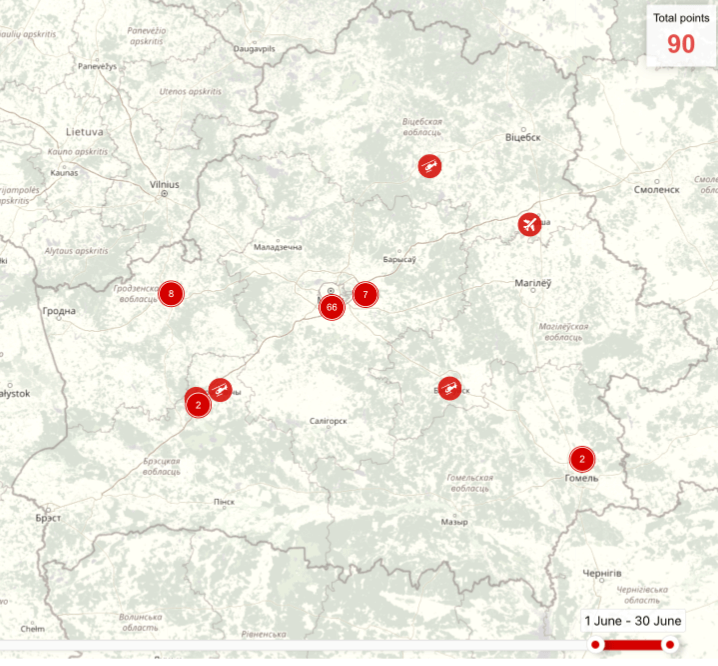
The intensity of flights of the Russian Aerospace Forces in Belarus almost didn’t change compared to May. In general, we can note that there was no significant increase in the main indicators of aviation activity in June (the intensity of flights of the aviation group stationed in Belarus and the number of arrivals of military transport and passenger aircraft).
As of July 1, 2023, the aviation group of the Russian Aerospace Forces in Belarus included:
- bombers: 8 pieces of Su-34 2 pieces of Su-24MR (stationed at Machulishchy and Lida airfields, respectively);
- fighters: 2 pieces Su-30SM (stationed at Machulishchy airfield);
- helicopters: 11 pieces of Mi-8, Mi-24 and Mi-28 (stationed at Baranavichy airfield).
There were the following changes in the number of the aviation group of the Russian Aerospace Forces in Belarus during the month:
- On June 22, a Mi-24 helicopter of the Russian Aerospace Forces crashed in the Baranavichy district. The nature of the damage to the helicopter indicates that it will need long repairs before it can return to flights. The probable cause of the helicopter crash was a technical malfunction.
- On June 22, a Mi-8 helicopter of the Russian Aerospace Forces (RF-90399) arrived from Russia. At the moment, the helicopter is stationed at Baranavichy airfield.
- On June 24, a Mi-8 helicopter of the Russian Aerospace Forces flew from Machulishchy airfield to Seshcha airfield (Bryansk oblast, Russia).
Therefore, the aviation group of the Russian Aerospace Forces decreased by one Mi-24 attack helicopter in June.
Arrivals of military transport and passenger aircraft of the Russian Aerospace Forces and other Russian state and military agencies at Belarusian airfields and airports continued. The aircraft arrived at:
— Machulishchy airfield: passenger — Tu-134AK, 1 An-148; transport — 12 Il-76, 1 An-26;
— Minsk National Airport: passenger — 1 Tu-204, 1 Il-96 (Special Flight Squad “Russia”); transport — 1 An-124 “Ruslan”;
— Lida airfield: passenger — 1 Il-22VPU (air command post); transport — 1 An-26;
— Homiel airport: transport — 1 An-26 and 1 An-12;
— Balbasava airfield (Orsha): passenger — Tu-134AK (Russian Rosgvardiya).
We note that the Il-22VPU air command post of the Russian Aerospace Forces was in Belarus from June 20 to June 29. According to our information, the aircraft took part in the Airforce drills, which were held on June 21-23 with the 116th assault aviation base of the Belarusian Air Force. After the end of the drills, the Il-22VPU made several more flights (on June 26 and June 27). In total, the aircraft stayed in Belarus for 9 days.
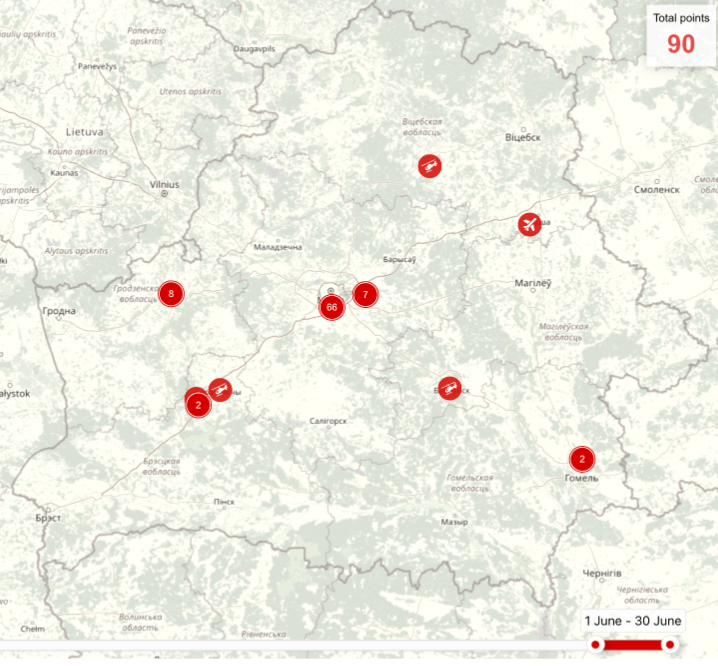
As you can see, the number of arrivals of military transport and passenger aircraft remained almost at the same level in June compared to May.
We should note that on June 24, 5 Il-76 military transport aircraft of the Russian Aerospace Forces arrived at Machulishchy airfield. The possible purpose of the arrival was the transfer of the military contingent from Belarus to Russia to take part in the suppression of “Prigozhin’s rebellion”. This is indicated by the fact that the aircraft arrived and left empty. In turn, the flights of passenger aircraft were primarily connected with the visits of Russian officials to Belarus.
We should also note that after a two-month break (from April 18 to June 16), two An-26 military transport aircraft and one An-12 of the Russian Aerospace Forces arrived at Homiel airport. According to our information, we should expect new arrivals of military transport aircraft of the Russian Aerospace Forces in July-August. We recall that 25 An-124 military transport aircraft of the Russian Aerospace Forces arrived at Homiel airport from March 25 to April 18. In general, the arrivals of transport aircraft can be connected with the activity of the Russian military at Ziabrauka airfield (see paragraph 2.4 of Chapter 2).
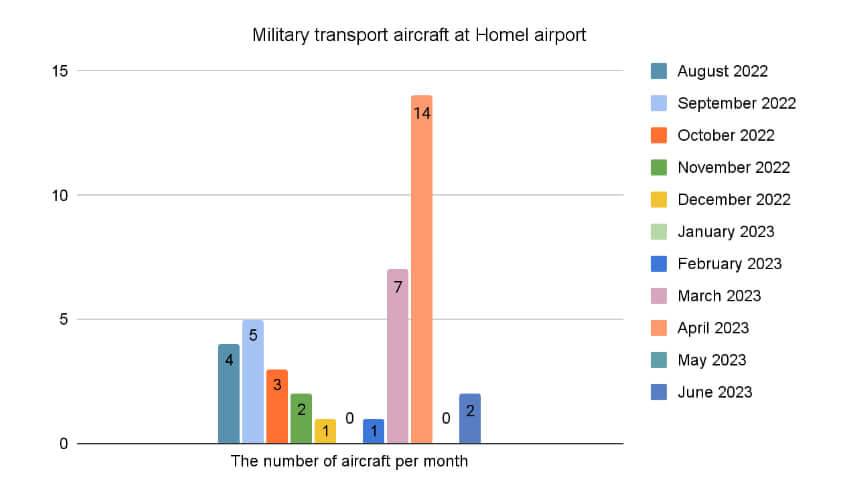
2.3. Missile strikes from the territory of Belarus.
Key points on paragraph 2.3:
- The threat of missile strikes from the territory of Belarus by ground-based and air-based systems remains.
- The withdrawal of MiG-31K aircraft from Belarus decreases the ability of the Russian Armed Forces to launch strikes with air-to-surface missiles.
- If necessary, the group of the Russian Aerospace Forces stationed in Belarus, as well as anti-aircraft missile systems of the Russian Armed Forces, can be used to launch missile strikes.
In June, no missile strikes against Ukraine from the territory of Belarus were recorded. We note that the last missile strike at the territory of Ukraine from the territory of Belarus was launched on October 6, 2022.
The withdrawal of MiG-31K fighter-interceptors capable of using Kinzhal hypersonic missiles from the territory of Belarus in April 2023 reduces the possibility of air-based missile strikes. At the same time, Su-34 and Su-24MR bombers, as well as Su-30SM fighters, which can be used for missile strikes against the territory of Ukraine if needed, remain at Machulishchy and Lida airfields. We should also keep in mind that S-300/4-00 SAM systems of the Russian Armed Forces are stationed at the airfield in Vialiki Bokau and Ziabrauka airfield (see paragraph 2.4 of Chapter 2), which can also be used to launch missile strikes.
The restriction zone for flights of all types of civil aircraft (including UAVs) at altitudes from 0 to 19,800 meters in the south of Belarus, extended according to NOTAMN O0403/23, is active until October 1, 2023. The ban on flights over the southern part of Belarus was introduced on February 24, 2022.
The facts mentioned above allow us to conclude that there’s a permanent threat of missile strikes from the territory of Belarus.
2.4. Military facilities at Ziabrauka airfield and the airfield in Vialiki Bokau.
Key points on paragraph 2.4:
- The Russian Armed Forces continue to use their military facilities in the southern regions of Belarus. Currently, there are no signs that this activity will stop.
- Military bases of the Air Defense Forces of the Russian Armed Forces are deployed at the airfield in Vialiki Bokau village (Mazyr district) and at Ziabrauka airfield (Homiel district).
Russian military equipment and servicemen were repeatedly spotted in and near Mazyr in June. This is indirect evidence of the presence of the Russian military at the airfield in Vialiki Bokau village (Mazyr district).
According to the satellite images dated May 6, the following was stationed at the airfield:
- 8 launchers of S-300/400 SAM system;
- 1 Pantsir-S1 self-propelled anti-aircraft gun and missile (SPAAGM) system;
- 3 5Т58 transport semi-trailer vehicles of S-300/400 SAM system;
- 1 armored personnel carrier;
- 18 trucks;
- 1 92N6 radar;
- 1 91N6 surveillance and tracking radar;
- 1 76N6 radar on the 40V6M universal mobile tower;
- 1 96L6E all-altitude detector on the 40V6 universal mobile tower;
- 6 pieces of unidentified military equipment;
- 8 mockups of military equipment (6 of them are S-300/400 SAM systems);
- 10 unknown objects under the camouflage net;
- 11 tents (1 USB-56, 1 UST-56, 4 М-10, 5 М-30, the total capacity is about 300 people).
Thus, the Russian Armed Forces use the territory of the airfield for their own purposes.
There was no new information about the condition of the Russian military base at Ziabrauka airfield. Information about the deployment of military equipment at the airfield is given in the table below.
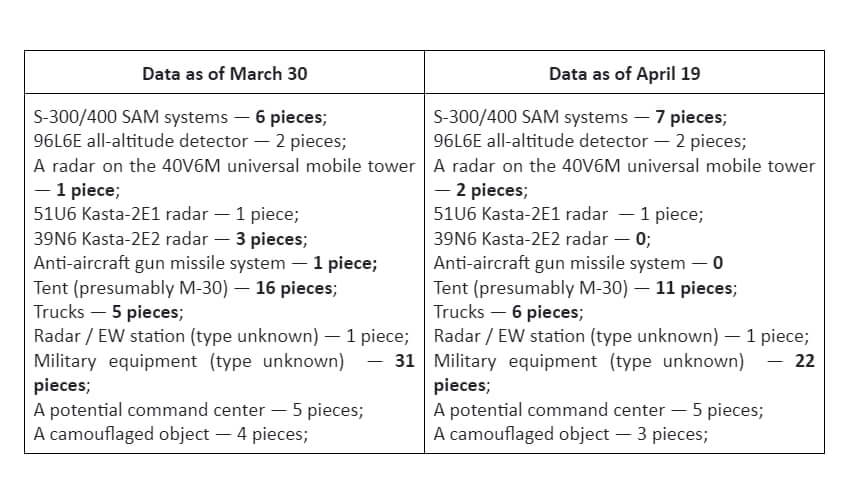
Thus, the airfield is still occupied by the Russian military without any legal status (such as a military base of the Russian Armed Forces, etc.). All this indicates that the Russian Armed Forces are planning to continue operating Ziabrauka airfield.
2.5. PMC Wagner in Belarus
Key points on paragraph 2.5:
- A large camp has been set up in the Asipovichy district to accommodate mercenaries of the PMC Wagner.
- The number of mercenaries who will arrive in Belarus, as well as their activities, is currently unknown.
After the announcement of Yevgeny Prigozhin’s leaving for Belarus, information began to spread that the PMC Wagner will leave together with him.
From June 23 to June 27, a large tent camp was built on the territory of the former military town of the 465th Missile Brigade of the Belarusian Armed Forces (military unit 61732) in Tsel village, Asipovichy district. In total, ≈298 tents were set up in the camp, which will be able to accommodate about 8000 people.
The available information allows us to make a preliminary conclusion that the mercenaries of the PMC Wagner will live in the camp, some of whom are expected to arrive in Belarus after the “march of justice” together with the owner of the PMC Yevgeny Prigozhin. At the same time, the main PMC units (with weapons and military equipment) have not yet arrived in Belarus. There may be a small group of PMC representatives in Belarus to organize accommodation of the majority of the mercenaries.
For more information about the PMC Wagner, see the brief dated June 27, 2023, “Yevgeny Prigozhin’s PMC Wagner in Belarus: Update.”
Chapter 3. General conclusions.
- During the month the Belarusian Armed Forces functioned as usual. Combat training activities were seasonal and scheduled.
Currently, there is no evidence that the Lukashenko regime is preparing its forces for joint participation with the Russian Armed Forces in combat operations against Ukraine. The Belarusian Armed Forces are still incapable of conducting an offensive operation against Ukraine on their own. There are still no reasons to believe that the Belarusian Armed Forces will be involved in combat operations in Ukraine in the medium term.
- Nothing new happened in the activity of the Russian Armed Forces on the territory of Belarus during the month. The forces and means are still concentrated at the training grounds of the Belarusian Armed Forces, far from the border with Ukraine. The main purpose for the deployment of the regional group of troops is still the training of the Russian military at the training grounds of the Belarusian Armed Forces for their further participation in combat operations in Ukraine. In general, the operation of the Russian military in Belarus has become a certain routine.
We can note a change in the trend from a decrease in the number of the Russian military stationed in Belarus to its gradual increase. At the same time, the number of troops can both increase and decrease at any moment. The number of the Russian contingent in Belarus shows that the Russian Armed Forces have no task to accumulate their forces in Belarus. Thus, Russia is not planning an offensive operation from the territory of Belarus in the short term. Therefore, the most probable scenario is currently Scenario №3. Belarus is a permanent training base for the Russian military.
Note. Scenario 3. Belarus is a permanent training base for the Russian military. In this scenario, Russian servicemen (mostly mobilized Russians) will arrive at the training grounds in Belarus, pass a course of military training, and leave for the combat zone. New mobilized soldiers will arrive instead. Its implementation is currently indicated by the following:
- Periodic intensification of movements of the Russian military by rail to/from Belarus.
- Lack of redeployment of military equipment of the Russian Armed Forces to the training grounds in Belarus (except the rotation of personnel).
The steps taken during the month (e.g. formation of a military investigation department) also indicate long-term plans for the Russian military presence in Belarus.
In addition to the previously mentioned key destabilizing factor of the military situation in Belarus (the deployment of TNW), another one has been added — the PMC Wagner. The announcement of the arrival of mercenaries in Belarus (there is no information about their mass arrival yet) has already caused a response from both Ukraine (in the form of strengthening the “northern direction”) and NATO countries bordering Belarus. Therefore, Ukraine was forced to react and pay more attention to the protection of the border with Belarus, which leads to the restraint of part of its reserves, which could have been used in other parts of the front.
